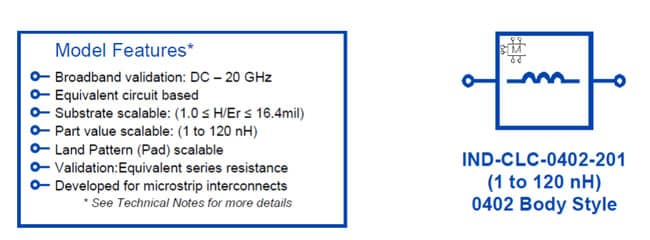Modelithics‘ ongoing initiative Modelithics Microwave Supermodels offers increasingly more models validated to higher frequencies (like mmWave range 50 or 67 GHz) for components in which higher-frequency validation makes sense.
There’s no question that mmWave frequencies have received a great deal of attention in recent years. Of course, much of this interest revolves around 5G along with the emerging topic of 6G. As a mmWave application space, 5G has been under the microscope for some time now.
Of course, the need for mmWave frequencies also extends to other arenas—for instance, mmWave radar is another application that demands performance at these higher frequencies.
Having said all this, one thing is clear: many companies recognize the need to offer products that perform at frequencies higher than ever before. For Modelithics, one ongoing initiative is to offer increasingly more models validated to higher frequencies (like 50 or 67 GHz) for components in which higher-frequency validation makes sense. This initiative not only applies to new models being released but also models originally developed in years past.
Many of these higher-frequency models were introduced in the latest version of the Modelithics COMPLETE Library. These models are also included in the Modelithics mmWave and 5G Library (every model in the mmWave and 5G Library is validated to at least 30 GHz—some as high as 125 GHz). We mentioned how this higher-frequency initiative is relevant even to existing models. Let’s explain that by talking about Modelithics Microwave Supermodels, which were introduced several years back.
One of the first Microwave Supermodels is the model for the Coilcraft 0402CS inductor series. When this model was first introduced as model number IND-CLC-0402-001, it was validated to 10 GHz and covered part values ranging from 1 to 47nH. It also had a substrate-scalability range (i.e., substrate height divided by dielectric constant) of 1 to 8 mils.
A second version was later introduced, followed by the currently available Microwave Supermodel (model number IND-CLC-0402-201). This Microwave Supermodel is validated to 20 GHz, covers a part-value range of 1 to 120 nH, and has a substrate scalability range of 1 to 16.4 mils (Fig. 1). It’s clear these numbers represent a pretty big jump compared to the original model.
Now, you’ll notice the IND-CLC-0402-201 Microwave Supermodel is validated to 20 GHz, which may seem like a pretty high frequency. But as mentioned earlier, Modelithics is currently making a push to extend the validated frequency range of certain models well beyond the original frequency range. That’s why you can now find Microwave Supermodels validated to frequencies much higher in comparison to the original models.
You may be wondering how all this is possible. Remember that the models being discussed here are based on actual lab measurements performed at Modelithics. So, these models really begin with the Modelithics lab team, which has extensive experience performing precise measurements of components mounted on printed-circuit-boards (PCBs) at frequencies to 110 GHz and even beyond.
A Microwave Supermodel is spawned when an existing Modelithics model is enhanced to allow for a wider range of performance. These performance enhancements include validations on additional substrates to enable a wider substrate scalability range. Other model enhancements include extending the validated frequency range and extending the part-value range.
Let’s now take a closer look at these higher-frequency Microwave Supermodels. We’ll stick with inductors by examining the model for the Murata LQP02TQ series. When this model was first introduced as model number IND-MUR-01005-003, it had a validated frequency range of DC to 30 GHz. That model was recently replaced with an updated version (model number IND-MUR-01005-103) that’s validated to 67 GHz. Figure 2 shows a schematic that includes this model in a two-port series configuration. The substrate used for this simulation is 4-mil-thick Rogers RO4350B. Figure 3 shows the simulated S11 and S21 for three inductance values. Note that the IND-MUR-01005-103 model covers an inductance range of 0.4 to 22 nH.
Let’s move beyond inductors and turn our attention to capacitors. In this case, let’s focus on the model for the Kemet CBR02 series (model number CAP-KMT-0201-201). This model is validated to 50 GHz, while the original model (model number CAP-KMT-0201-001) was only validated to 20 GHz. Figure 4 shows the simulated (two-port series configuration) S11 and S21 for three capacitance values. The substrate used this time is 6.6-mil-thick Rogers RO4350B. Note that the CAP-KMT-0201-201 model covers a capacitance range of 0.1 to 39 pF.
On a final note, expect to see more of these higher-frequency Microwave Supermodels in the future. On top of that, be on the lookout for application notes and other content in the days ahead that demonstrate practical higher-frequency design examples made possible by Microwave Supermodels as well as brand new models validated to higher frequencies.
References
- I. Bedford, H. Patel, and L. Levesque, “Application Note 058: Accelerating Designs With Modelithics Microwave
Supermodels™.” - C. DeMartino, E. O’Dell, and L. Dunleavy, “Application Note 067: Utilizing Substrate Scalability of Modelithics Models in
Keysight ADS.” - Modelithics literature: https://www.modelithics.com/Literature/AppNote
